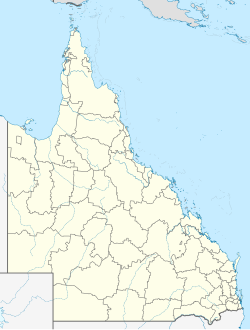History
In 1955, New Zealand geologist Harry Evans discovered bauxite (the raw material used to make aluminium) on the western coast of Cape York Peninsula while he was exploring for oil. Further surveys established it was the largest bauxite deposit in the world. [3]
In November 1957, the Queensland Government approved a £50 million project of the British Australian Consolidated Zinc group to develop a bauxite mine on the Cape York Peninsula to be operated by its newly created subsidiary, Commonwealth Aluminium Corporation Pty. Limited (from 1960 known as Comalco). As part of the agreement, the government passed legislation to enable a town, harbour and treatment works to be established at the company's expense at Kumrunja (Rocky Point) on the south side of the Mission River. Under the Commonwealth Aluminium Corporation Pty. Limited Agreement Act (1957) the area for the town was excised from Shire of Cook and Comalco became the manager of the new town. [4] [5]
In 1964, the first housing was constructed in the new township of Weipa at Rocky Point. [5] In 1967 the Township of Weipa was officially opened by the Queensland Premier Frank Nicklin. [6]
In 1993, Comalco held elections to form a Citizens Advisory Committee to assist in the administration of the town. In 1997 the committee evolved into the present Weipa Town Authority. [5] [7]
Demographics
Weipa Town was included in the Shire of Cook for census purposes until its first census reporting in 2006.
In the 2006 census, the Weipa Town had a population of 2,830 people. [8]
In the 2011 census, the Weipa Town had a population of 3,334 people. [9]
In the 2016 census, the Weipa Town had a population of 3,905 people. [10]
In the 2021 census, the Weipa Town had a population of 4,100 people. [1]
Weipa Town Authority
While Rio Tinto (formerly Comalco) remains responsible for the administration of the town, it discharges this obligation through the Weipa Town Authority. The Authority has seven members: four elected by the residents, two appointed by Rio Tinto, and one appointed by the Alngith indigenous people. Weipa Town is a gazetted local government area and the Weipa Town Authority undertakes the duties of a typical local government, such as: [12]
- town planning and community development
- providing infrastructure and services
- making and enforcing local laws
- levying local government rates and charges
Services provided by the authority include road maintenance, water supply, garbage collection, parks, sports ovals, and public swimming pools. [12] The authority provides the Hibberd Library in Hibberd Drive, Rocky Point. [13]
However, the Weipa Town Authority is not a true local government authority as defined in the Local Government Act (2009) because it is part of a corporation. This has implications in relation to loan and budget requirements, Goods and Services Tax on rates, the development of land, and changes to the town boundaries. [12]
Unlike other local governments in Queensland, the Weipa Town Authority has a chairman rather than a mayor. In 2017, the chairman is Michael Rowland. [5]
In 2016, discussions took place in regard to "normalising" Weipa Town into a true local government authority . The three options under discussion were to make Weipa Town a normal local government authority with its present boundaries, to absorb Weipa Town back into the Shire of Cook, or to create a new Western Cape Region centred on Weipa. [14]
This page is based on this
Wikipedia article Text is available under the
CC BY-SA 4.0 license; additional terms may apply.
Images, videos and audio are available under their respective licenses.


